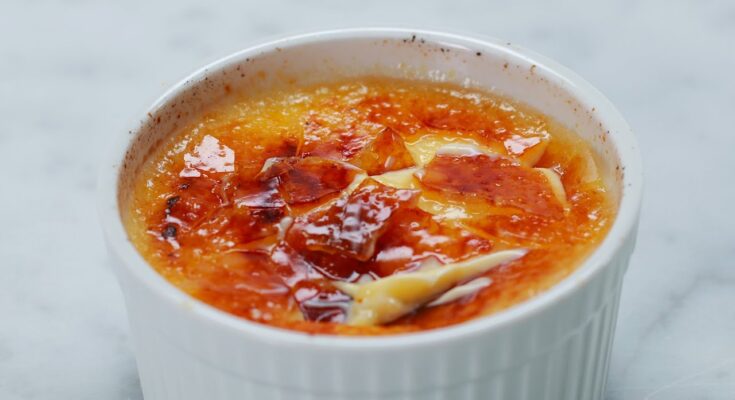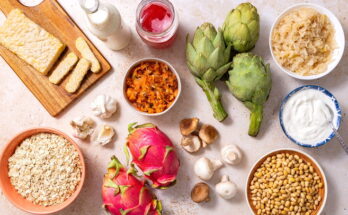Creme Brulee Recipe: Crème Brûlée is a classic French dessert known for its creamy, rich custard base topped with a thin layer of caramelized sugar. This elegant dessert offers a delightful contrast between the silky smooth custard and the crunchy sugar topping, which cracks under the tap of a spoon. Crème Brûlée translates to “burnt cream,” referring to the torched sugar crust on top.
This dessert has become a favorite around the world due to its luxurious texture and subtle vanilla flavor. Whether served at a fancy dinner party or enjoyed at home, Crème Brûlée is a dessert that leaves a lasting impression. The best part? It’s not as complicated as it looks. With a few simple ingredients and some careful steps, you can master it in your own kitchen!
Ingredients Needed for Crème Brûlée
For the Custard:
- 2 cups heavy cream
- 5 large egg yolks
- ½ cup granulated sugar
- 1 vanilla bean (or 1 tsp vanilla extract)
- A pinch of salt
For the Caramelized Sugar Top:
- ¼ cup granulated sugar
Optional Variations:
- Chocolate chips for a chocolate twist
- A teaspoon of espresso powder for coffee lovers
- Lavender flowers for a floral aroma
Equipment Needed for Crème Brûlée
- 4 to 6 ramekins (ceramic dishes)
- A baking dish for the water bath
- Whisk and mixing bowls
- Measuring cups and spoons
- Strainer (optional, for a smoother texture)
- Blowtorch (or oven broiler) for caramelizing the sugar
Step-by-Step Instructions to Make Crème Brûlée
Step 1: Preheat the Oven and Prepare Ramekins
Preheat your oven to 325°F (160°C). Place the ramekins in a large baking dish. The baking dish will later be filled with hot water to create a water bath, which ensures gentle, even cooking of the custard.
Step 2: Heat the Cream with Flavoring
In a saucepan, heat the heavy cream over medium heat. If using a vanilla bean, split it lengthwise, scrape out the seeds, and add both the seeds and pod to the cream. Warm the cream until it’s just about to simmer (but not boiling), then remove it from the heat and let it steep for 10 minutes to enhance the vanilla flavor.
Step 3: Whisking the Egg Yolks and Sugar
In a bowl, whisk the egg yolks and sugar until the mixture becomes pale and slightly thickened. This step ensures the custard will have a creamy texture. Be careful not to overwhisk, as it could create too many air bubbles, which you want to avoid in the final dessert.
Step 4: Combine Cream and Egg Mixture Gradually
Slowly pour the warm cream into the egg mixture, whisking continuously to prevent the eggs from scrambling. If the cream is too hot, it could cook the eggs, so it’s important to pour slowly and stir constantly.
Step 5: Strain the Mixture for a Smooth Texture
Strain the custard mixture through a fine-mesh sieve to remove any lumps or vanilla bean pieces. This step ensures a silky-smooth texture for the custard.
Step 6: Pour Custard into Ramekins and Bake
Pour the strained custard evenly into the ramekins. Fill the baking dish with hot water until it reaches halfway up the sides of the ramekins. Bake for 40-45 minutes, or until the custard is set but still slightly jiggly in the center.
Step 7: Chill the Custard to Set
Remove the ramekins from the water bath and let them cool to room temperature. Then, refrigerate them for at least 4 hours (or overnight) to allow the custard to set properly.
Step 8: Caramelizing the Sugar Top
When ready to serve, sprinkle a thin, even layer of sugar on top of each custard. Use a blowtorch to caramelize the sugar until it turns golden brown. If you don’t have a blowtorch, you can place the ramekins under a hot oven broiler for a few minutes—just watch closely to avoid burning.
Tips for the Perfect Crème Brûlée
- Use fresh ingredients: The quality of your eggs, cream, and vanilla greatly affects the final result.
- Avoid air bubbles: Straining the custard before baking removes any unwanted bubbles for a smoother texture.
- Don’t rush the chilling process: Patience is key—allow the custard to chill properly to achieve the perfect consistency.
Flavor Variations of Crème Brûlée
- Chocolate Crème Brûlée: Add melted chocolate to the cream for a rich twist.
- Coffee Crème Brûlée: Stir in a teaspoon of espresso powder for a bold flavor.
- Citrus Crème Brûlée: Add orange zest for a refreshing citrus touch.
Serving Suggestions and Presentation Ideas
Top your Crème Brûlée with fresh berries, edible flowers, or a dusting of powdered sugar for a beautiful presentation. Serve it with a side of biscotti or a scoop of vanilla ice cream for an extra treat.
FAQs about Crème Brûlée Recipe
1. What is Crème Brûlée?
Crème Brûlée is a classic French dessert made with a creamy custard base topped with a layer of caramelized sugar. Its silky texture pairs beautifully with the crunchy, burnt sugar topping.
2. What ingredients do I need for Crème Brûlée?
The main ingredients are heavy cream, egg yolks, sugar, and vanilla extract. Some recipes may also include a hint of liqueur or citrus zest for added flavor.
3. How do I get the perfect caramelized topping?
You can achieve the signature caramelized top by sprinkling sugar over the custard and using a kitchen torch to burn the sugar evenly. If you don’t have a torch, placing the custard under a broiler for a few minutes can also work.
4. How long does Crème Brûlée take to set?
After baking, the custard needs to cool at room temperature and then chill in the refrigerator for at least 4 hours, or overnight, to set properly.
5. Can I make Crème Brûlée ahead of time?
Yes, Crème Brûlée is an excellent make-ahead dessert. Prepare the custard and store it in the fridge for up to two days. Just caramelize the sugar layer right before serving to maintain the crunch.
6. Why is my Crème Brûlée not setting?
If your custard is runny, it may have been undercooked. Ensure it bakes in a water bath at a low temperature (around 160°C/325°F) until the edges are set but the center still jiggles slightly.
7. What can I use if I don’t have a torch?
If you don’t have a torch, place the Crème Brûlée under the oven broiler for 2–3 minutes. Keep a close eye to prevent burning.
8. How do I know Crème Brûlée is done baking?
Crème Brûlée is ready when the custard is set around the edges but still has a slight wobble in the center. Overcooking will result in a grainy texture.
9. What is the ideal serving temperature for Crème Brûlée?
Crème Brûlée is best served cold, straight from the fridge, with the caramelized sugar freshly burnt to provide a warm, crunchy contrast.
10. Can I add different flavors to Crème Brûlée?
Yes! Infuse the cream with flavors like lavender, coffee, or chocolate. You can also top it with fresh berries or fruit compote for a creative twist.
Conclusion
Making crème brûlée at home is easier than it seems, especially with the right steps and a little patience. With practice, you’ll master this elegant dessert, impressing guests or treating yourself to a little luxury. Now that you know the process, it’s time to grab those ramekins and start whisking!
References
For further reading and to validate the information provided in the Crème Brûlée Recipe, we recommend consulting the following reputable sources. These references offer expert insights, additional tips, and variations to help perfect your crème brûlée:
- AllRecipes – Known for its detailed recipes and user-generated reviews, AllRecipes provides valuable tips on achieving the perfect custard texture.
- Bon Appétit – This culinary authority offers professional techniques, including how to caramelize the sugar top flawlessly.
- The Spruce Eats – Explore detailed troubleshooting tips to avoid common mistakes in your crème brûlée preparation.
- Serious Eats – This platform dives deep into the science behind cooking, ensuring you understand the nuances behind each step in the recipe.
- BBC Good Food – A trusted source for international recipes, BBC Good Food shares alternative flavor ideas to experiment with your crème brûlée.
These sources will enrich your understanding and provide guidance for mastering crème brûlée, ensuring your dessert is a delightful success.



